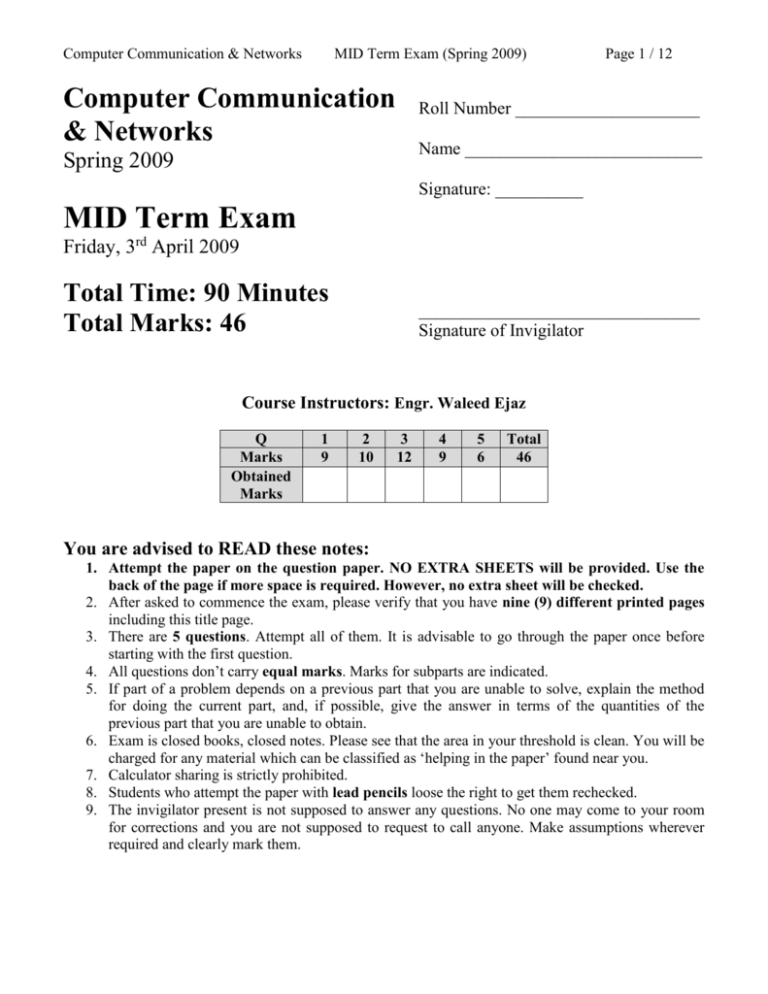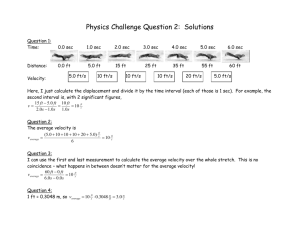View File
advertisement

Computer Communication & Networks MID Term Exam (Spring 2009) Computer Communication & Networks Page 1 / 12 Roll Number _____________________ Name ___________________________ Spring 2009 Signature: __________ MID Term Exam Friday, 3rd April 2009 Total Time: 90 Minutes Total Marks: 46 ________________________________ Signature of Invigilator Course Instructors: Engr. Waleed Ejaz Q Marks Obtained Marks 1 9 2 10 3 12 4 9 5 6 Total 46 You are advised to READ these notes: 1. Attempt the paper on the question paper. NO EXTRA SHEETS will be provided. Use the back of the page if more space is required. However, no extra sheet will be checked. 2. After asked to commence the exam, please verify that you have nine (9) different printed pages including this title page. 3. There are 5 questions. Attempt all of them. It is advisable to go through the paper once before starting with the first question. 4. All questions don’t carry equal marks. Marks for subparts are indicated. 5. If part of a problem depends on a previous part that you are unable to solve, explain the method for doing the current part, and, if possible, give the answer in terms of the quantities of the previous part that you are unable to obtain. 6. Exam is closed books, closed notes. Please see that the area in your threshold is clean. You will be charged for any material which can be classified as ‘helping in the paper’ found near you. 7. Calculator sharing is strictly prohibited. 8. Students who attempt the paper with lead pencils loose the right to get them rechecked. 9. The invigilator present is not supposed to answer any questions. No one may come to your room for corrections and you are not supposed to request to call anyone. Make assumptions wherever required and clearly mark them. Computer Communication & Networks Question 1 MID Term Exam (Spring 2009) Page 2 / 12 [3+6] 1. The following diagram shows the bottom three layers of OSI model on two machines. a. Which layers on which machines would be affected if the protocol defined for layer 2 on machine A was changed? Solution: Layer 2 on machine B b. Which layers on which machines would be affected if the service defined for layer 1 on machine A was changed? Solution: Layer 2 on machine A 2. Consider the sliding window ARQ protocol. Suppose that the protocol uses a very large sequence number space that would not wraparound, and it starts from 0. And the sender always has frames to send. The receiver always sends an ACK when receiving a CRC-validated data frame. Let SWS = 2 and RWS = 1. Moreover, we introduce a new retransmission scheme to the sender. In this scheme, the sender will immediately send the oldest unacknowledged frame if it receives an old ACK. An ACK is considered old if it has been received before or the value of the ACK is 0. Assume that this retransmission scheme always retransmits earlier than the case with timeout mechanism. a. Draw a time-line diagram for the case where the first data frame (SN = 0) has bit errors and is dropped by the sender. All subsequent transmissions (data and ACK) are assumed to be error-free. Draw the diagram until the receiver’s NFE (next frame expected) = 3. Computer Communication & Networks Part a: MID Term Exam (Spring 2009) A S=0 B F0 R=0 F1 Ack F0 discards F1 S=0 F0 R=0 R=1 Ack F1 S=1 F1 R=1 R=2 Ack F2 S=1 F2 R=3 Ack F3 Page 3 / 12 Computer Communication & Networks MID Term Exam (Spring 2009) Page 4 / 12 b. Draw a time-line diagram for the case where the transmissions of the first data frame (SN = 0) and its ACK are error-free, but the second data frame (SN = 1) has bit errors and is dropped by the sender. All subsequent transmissions (data and ACK) are assumed to be error-free. Draw the diagram until the receiver’s NFE (next frame expected) = 3. Part b: A B S=0 F0 R=0 R=1 Ack F1 F1 S=0 F2 Discards F1 Ack F1 S=1 F1 Ack F2 R=1 R=2 S=1 F2 Ack F3 R=2 R=3 S=3 R=3 R=4 Computer Communication & Networks MID Term Exam (Spring 2009) Page 5 / 12 Question 2 [2+2+2+4] 1. What is the channel capacity for a teleprinter channel with a 300 Hz bandwidth and a signal-to-noise ratio of 30 dB, where the noise is white thermal noise? 2. Use PCM to translate voice signal. How much data rate is required? 3. A digital signaling system is required to 9600bps and the channel bandwidth is 1.2 KHz. What is the maximum numbers of discrete voltage levels? 4. A telephone line is known to have a loss of 30 dB. The input signal power is measured as 0.1 W, and the output noise level is measured as 2.5μW. calculate the output signal-to-noise ratio in dB. (log2=0.301) Computer Communication & Networks MID Term Exam (Spring 2009) Question 3 Page 6 / 12 [6+6] 1. The mapping between messages a1a2a3a4 and codewords a1a2a3r3a4r2r1 of a (7, 4) Block code is given as follows. We use Hamming Code to add even-parity-checks bits, where r1=a1+a3+a4, r2=a1+a2+a4, and r3=a1+a2+a3 a. Given two messages m1=1000 and m2=0101, find the codewords w1 and w2. Solution: w1=1001011, w2=0101101 b. What is the Hamming distance of codewords w1 and w2? What is the code rate? c. Determine the Minimum distance and error-correction capacity this code Message 0000 0001 0010 0011 0100 0101 0110 0111 Codeword 0000000 0000111 0011001 0011110 0101010 ? 0110011 0110100 Message 1000 1001 1010 1011 1100 1101 1110 1111 Codeword ? 1001100 1010010 1010101 1100001 1100110 1111000 1111111 Computer Communication & Networks MID Term Exam (Spring 2009) Page 7 / 12 2. The following block of bits is received at the input to a channel decoder: 11001000101001 Determine if this block of bits contains any bit errors (and, if possible, the locations of any such errors) if the channel coding scheme is based on: a. Even Parity b. Odd parity based hamming Coding c. CRC-4 coding with a generator polynomial of G(x)= x4+x3+1 Comment on the limitations of each scheme in terms of the maximum number of bit errors that can be reliably processed in a single block. (a) 11001000101001 No Error is detected it can detect 1 bit or odd numbers of errors. (b) 1 1 0 0 1 000101001 14 13 12 11 10 9 8 7 6 5 4 3 2 1 r8 r4 r2 r1 r1 1 3 5 7 9 11 13 1 r2 2 3 6 7 10 11 14 0 r4 4 5 6 7 12 13 14 1 r8 8 9 10 11 12 13 14 0 Hamming distance limitizes error detection and correction capability. Computer Communication & Networks (c) MID Term Exam (Spring 2009) Page 8 / 12 1000000011 11001 11001000101001 11001 000000 000000 000000 000000 0000 0000 0001 0000 0010 0000 0101 0000 1010 0000 10100 11001 Limitations: It can only detect not correct the errors 11011 11001 010 Remainder Question 4 [1+1+1+2+2+2] We are sending a 30 Mb file from a source host to a destination host. Suppose the message sent consists of the entire file. All links in the path between source and destination have a transmission rate of 10 Mbps. Assume that the propagation speed of each link is 2 * 108 meters/sec, and the distance between source and destination is 10,000 km. a. Initially, suppose there is only one link between source and destination. What is transmission delay? transmission delay is dtransmission = message size = 30 Mbits = 3 sec transmission rate of outbound link 10 Mbps b. Referring to the above question, what is the end-to-end delay (transmission delay plus propagation delay)? Computer Communication & Networks MID Term Exam (Spring 2009) Page 9 / 12 dprop = distance = 107 meters = 0.05 sec speed 2 X 108 meters/sec dend-to-end= dtransmission + dprop = 3 + 0.05 = 3.05 sec c. Referring to the above question, how many bits will the source have transmitted when the first bit arrives at the destination? At time t=0, the first bit will be pushed out from the source and it will incur a propagation delay = 0.05 sec. So, it will arrive at B at t = 0.05 sec. The transmission rate of the link is 10 Mbps. So, when the first bit arrives at B in 0.05 sec, the source will have transmitted: 10 Mbps X 0.05 sec = 0.5 Mbits = 0.5 X 106 = 500,000 bits d. Now, suppose there are two links between source and destination, with one router connecting the two links. Each link is 5,000 km long. Suppose processing delay is negligible and there is no congestion, so that the message is transmitted onto the second link as soon as the router receives the entire message. What is the end-to-end delay? processing delay is negligible and there is no congestion, so that the message is transmitted onto the second link as soon as the router receives the entire message. The end-to-end delay is dtransmission (Source-Router) = message size = 30 Mbits = 3 sec Computer Communication & Networks MID Term Exam (Spring 2009) Page 10 / 12 transmission rate of outbound link 10 Mbps dprop (Source-Router) = distance = 5 X 106 meters = 0.025 sec speed 2 X 108 meters/sec The transmission and propagation delays from Router to Destination are the same. dend-to-end= (dtransmission + dprop ) X 2 = (3 + 0.025) X 2 = 6.05 sec e. Now, suppose there is only one link between source and destination, and there are 10 TDM channels in the link. The file is sent over one of the channels. What is the end-to-end delay? Transmission rate of one channel= link transmission rate=10 Mbps = 1 Mbps no. of channels 10 channels dtransmission = message size = 30 Mbits = 30 sec transmission rate of outbound link 1 Mbps dprop = distance = 107 meters = 0.05 sec speed 2 X 108 meters/sec dend-to-end= dtransmission + dprop = 30 + 0.05 = 30.05 sec f. Now, suppose there is only one link between source and destination, and there are 10 FDM channels in the link. The file is sent over one of the channels. What is the end-to-end delay? Transmission rate of one channel = 10 Mbps = 1 Mbps Computer Communication & Networks MID Term Exam (Spring 2009) Page 11 / 12 10 channels dtransmission = message size = 30 Mbits = 30 sec transmission rate of outbound link 1 Mbps dprop = distance = 107 meters = 0.05 sec speed 2 X 108 meters/sec dend-to-end= dtransmission + dprop = 30 + 0.05 = 30.05 sec Question 5 [3+3] a. Suppose that a synchronous serial data transmission is clocked by two clocks (one at the sender and one at the receiver) that drift one minute per day in opposite direction. Assume that a bit waveform will be good if it is sample within 40 percent of its center. How long a sequence of bits can be sent before possible clock drift could cause a problem? b. A data source produces 15-bit characters. We use synchronous transmission, with a frame consisting of 176 control bits and 1024 information bits. The information field contains 16-bit (parity included) characters. Derive as expression of the maximum effective data rate over a 2 kbps line. Computer Communication & Networks MID Term Exam (Spring 2009) Page 12 / 12









